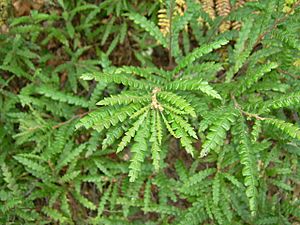Sweetfern facts for kids
Quick facts for kids Sweetfern |
|
|---|---|
 |
|
| Scientific classification | |
| Genus: |
Comptonia (plant)
|
| Species: |
peregrina
|
| Synonyms | |
|
|
The Sweetfern (scientific name: Comptonia peregrina) is a type of flowering plant. It belongs to the Myricaceae family. Even though it's called "sweetfern," it's actually a shrub, not a fern! It's the only living species in its group, called Comptonia.
Sweetfern grows naturally in eastern North America. You can find it from southern Quebec in Canada, all the way east to Nova Scotia. It also grows south to northern Georgia and west to Minnesota in the United States. In Quebec, people sometimes call it comptonie voyageuse.
Contents
What Does Sweetfern Look Like?
Sweetfern is a deciduous shrub, which means its leaves fall off in autumn. It can grow up to about 5 feet (1.5 meters) tall.
Sweetfern Leaves
The leaves of the sweetfern are long and narrow. They are usually between 1.2 to 6 inches (3 to 15 cm) long and 0.1 to 1.2 inches (0.3 to 3 cm) wide. They have a wavy or lobed edge. If you crush the leaves, they give off a lovely sweet smell!
Sweetfern Flowers
Sweetfern plants have both male and female flowers on the same plant. This is called being monoecious. The male flowers grow in bunches at the ends of branches and can be up to 2 inches (5 cm) long. The female flowers are much smaller, only about 0.2 inches (5 mm) long. But when the fruits start to grow, these female parts get longer, also reaching about 2 inches (5 cm).
Where Does Sweetfern Grow?
Sweetfern is found across eastern North America. Its range goes from Ontario and Quebec in the north, east to Nova Scotia. It reaches as far south as Georgia and west to Minnesota.
This plant likes to grow in dry, sandy places. You often see it growing near pine trees.
Sweetfern and Other Living Things
Sweetfern is an important plant for many creatures.
Food for Insects
The leaves of the sweetfern are a food source for the young forms (called larvae or caterpillars) of several types of moths. Some of these include the grey pug moth, the setaceous Hebrew character moth, and the Io moth. Several types of Coleophora case-bearer moths also feed on sweetfern. One of them, C. peregrinaevorella, eats only sweetfern!
Helping the Soil
Sweetfern is special because it can help the soil. It's a "non-legume nitrogen fixer." This means it can take nitrogen gas from the air and turn it into a form that plants can use. This helps to make the soil healthier for other plants to grow.
How People Use Sweetfern
Sweetfern has been used by people for different purposes.
Edible Parts
The plant produces a spiky burr. Inside this burr, you can find one to four small, edible nuts.
Sweetfern Tea
The leaves of the sweetfern, whether fresh or dried, can be used to make a tea. A Canadian writer named Catharine Parr Traill wrote about it in her book, The Female Emigrant's Guide. She said it could be used instead of regular tea. She noted that when boiled, it has a slightly "resinous taste, with a bitter flavour, that is not very unpleasant."
Traditional Uses
Tea made from sweetfern has also been used to help with the effects of poison ivy. People would apply the tea to the skin where the poison ivy rash was. The plant has also been used as a seasoning in food.
Images for kids
See also
 In Spanish: Comptonia para niños
In Spanish: Comptonia para niños


